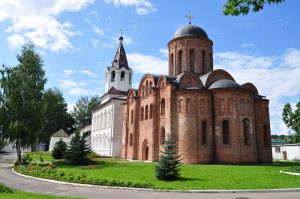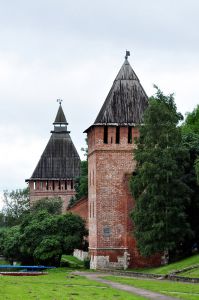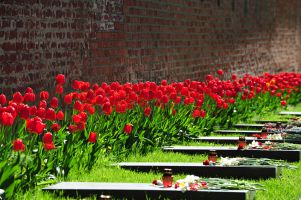- Main
- Smolensk region
- Historical guide
Historical guide
 The Smolensk land starts its history in the middle of the first century AD, when eastern Slavic tribes unite into large tribal unions. This was proceeded by the assimilation by Baltic and Finno-Ugrian tribes of the north-west and north of the European part of the East- European plain, that started in the third century AD.
The Smolensk land starts its history in the middle of the first century AD, when eastern Slavic tribes unite into large tribal unions. This was proceeded by the assimilation by Baltic and Finno-Ugrian tribes of the north-west and north of the European part of the East- European plain, that started in the third century AD.
The first mentioning of Smolensk in the chronicles refers to 863.
One of the largest tribal unions, the Krivichi, inhabited the territory of the present Smolensk oblast. The union of the lands with the centre in Smolensk had been already established by the time Oleg included the territory of the tribal union into Kievan Rus.
This dominating position of the powerful Krivichi union’s capital stimulates centripetal processes, uniting rather large territories around it. With strengthening of Smolensk and establishing links with neighbouring Kiev and Novgorod political centers, the Smolensk land becomes one of the key territories of Old Russian State and later Kievan Rus. This was to a large extent defined by the territory’s location as of a route trade center.
Being situated on the intersection of the main roads of Old Russian World, the Smolensk land began to form as an important infrastructure centre of international trade. It acquired its specialization of constructing and arranging ways for transportation goods – portages, building of trade boats and other means of transport, maintenance of fortified customs, guarding of roads and convoying cargoes during navigation period, production of export goods and raw materials.
The capital of the land – Smolensk was a big centre of crafts, trade and culture in Old Russian State. According to the regulations of “Smolensk Trade Truth” (“Smolenskaya Torgovaya Pravda”), the trade agreement between Smolensk, Riga and Gotland, registered in 1229, the geography of trade links, in which Smolensk actively participated, was rather broad. Among them were Gotland, Lubek, Bremen, Kassel, Groningen, Munstr, Dortmund, Braunshweig, Westphalia and Riga.
 It was due to the active role in international economic relations that princes of Smolensk got to play with time a significant part in the political life of Kievan state. They participated in marches of Kievan princes to Byzantium, Novgorod princes to Polotsk and Kiev, successfully struggled for the Grand Prince throne. In the middle of the XI century Kievan Rus broke down into a number of separate princedoms and Smolensk became one of the most powerful ones.
It was due to the active role in international economic relations that princes of Smolensk got to play with time a significant part in the political life of Kievan state. They participated in marches of Kievan princes to Byzantium, Novgorod princes to Polotsk and Kiev, successfully struggled for the Grand Prince throne. In the middle of the XI century Kievan Rus broke down into a number of separate princedoms and Smolensk became one of the most powerful ones.
Historical processes in the XIII century, which took place on the territory of Old Russian State, such as, the downfall of Kiev and Novgorod political centers and the rise of Moscow and Vilno, contributed to significant changes in the political position of the Smolensk land.
In 1404 the Smolensk land for 110 years came under the jurisdiction of the Grand Duchy of Lithuania. Meanwhile, Lithuanian princes reserved relative autonomy and immunity rights for the local Byelorussian and Great Russian feudals. Smolensk became a major economic, trade and cultural center of a bordering region between Byelaya and Great Rus.
At the same time the joining of Smolensk was a crucial problem for Moscow princes and a necessary condition for bringing all Russian lands into a single state.
In 1514 Lithuanian garrison had to stop the resistance and lay down the arms under the powerful attacks of the Grand Prince of Moscow Vasily III.
Smolensk became “the key to Muscovy”, the guard of Russia at its western borders. That was the reason why it was decided to build a fortress wall around it. Fyodor Savelyev, Kon by nickname, who was the most distinguished architect, famous for having built the white town in Moscow, directed the building of the fortress.
In the spring of 1596 Boris Godunov arrived in Smolensk to see the foundation of the new Smolensk fortress being laid. The building took six years. The total length of the fortress was about 6.5 km. It had 38 towers of various shape and size. The height varied between 13 and 19 m, the breadth reached 6 m. The Smolensk fortress did not have rivals in Russian architecture of XVII century. Boris Godunov called it “a precious necklace of all Christian Russia”.
Later on, the Smolensk lands were twice taken over by the neighbouring states, but after the victory of the Russian army in the war with Polish Kingdom for Ukrainian, Byelorussian and West-Russian lands, Smolensk was finally annexed by the Russian state.
 A special page of the history of Smolensk belongs to the War of 1812. The glorious victory of the Russian army over the French troops reminds about itself by the monuments and names of the streets.
A special page of the history of Smolensk belongs to the War of 1812. The glorious victory of the Russian army over the French troops reminds about itself by the monuments and names of the streets.
The end of that, now belonging to distant past war, was to a large extent predetermined on the Smolensk land. The French army lost more than 20.000 people at the walls of Smolensk.
When after exhausting bloody battles the Russian army left the town, all the citizens followed it.
The second half of the XIX century is the period of rising and development of Russian culture. At the end of the XIX century in Smolensk a gymnasium, a real school and a library were opened. A public theatre was opened in 1866. In 1888 in Smolensk the first museum of history and archeology was established. In 1898 in Talashkino the museum of history and ethnography was created and opened by M.K.Tenisheva.
The town continued developing after the October revolution of 1918. During this period in Smolensk and the oblast a great number of big industrial enterprises, such as, a flax mill, a machinery construction plant and many others were built.
But again the peaceful development was interrupted by war. In the summer of 1941 the Smolensk land became a battlefield and held up Hitler’s army offensive on Moscow for two months.
For more than two years Smolensk had remained in the hands of the enemy. After the German-Fascist occupation in Smolensk there remained only 7% of not destroyed residential buildings. More than 100 industrial enterprises were destroyed. In ruins lied Vyazma, Gzhatsk, Yelnya, Dorogobuzh, Velizh, Demidov, Dukhovchina, Roslavl.
The economy of Smolensk was restored within the shortest period of time. Very soon the industrial output exceeded the pre-war level and kept on growing.
Smolensk was awarded the title of the Hero-city for the great services of its citizens to their hometown. It bears the title with dignity.
 Smolensk land gave to the world the pleiade of outstanding people: the founder of Russian classic music – M.I. Glinka, outstanding travellers-researchers N.M. Przhevalsky and P.K. Kozlov, diplomat and writer A.S. Griboedov, famous scientists V.V. Dokuchaev, A.N. Engelgardt, poets A.T. Tvardovsky, M.V. Isakovsky, N.I. Rylenkov, the first astronaut – Y.A. Gagarin and many others.
Smolensk land gave to the world the pleiade of outstanding people: the founder of Russian classic music – M.I. Glinka, outstanding travellers-researchers N.M. Przhevalsky and P.K. Kozlov, diplomat and writer A.S. Griboedov, famous scientists V.V. Dokuchaev, A.N. Engelgardt, poets A.T. Tvardovsky, M.V. Isakovsky, N.I. Rylenkov, the first astronaut – Y.A. Gagarin and many others.
In Smolensk 3 churches of the XII century, the Assumption cathedral and 4 monasteries have been well preserved. The Assumption Cathedral functions.
Smolensk region is attractive for tourists all year around because of its rich history, delightful nature and wonderful appearance of ancient towns.
Having visited this land once, you will never forget these places, you will be surprised by the creations of hand and mind of man, rich cultural heritage, hospitality and friendliness of the people of Smolensk region.
